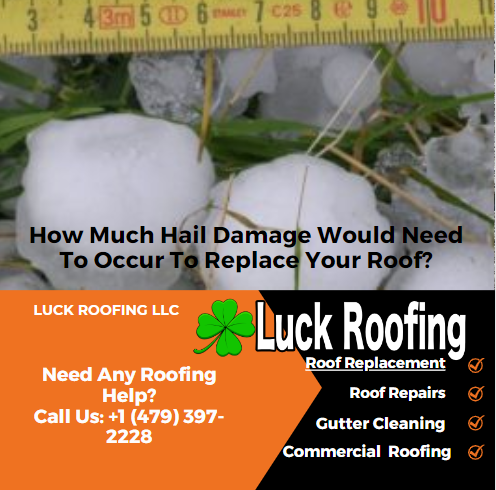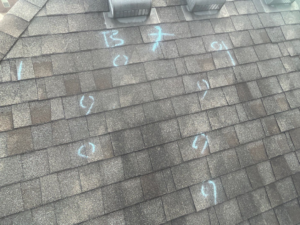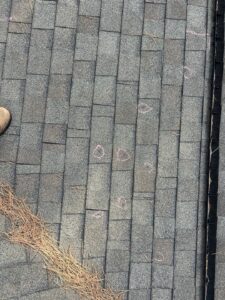
How Much Hail Damage Do You Need to Replace Your Roof?
After a hailstorm, homeowners are often faced with the critical decision of repairing or replacing their damaged roofs. This guide aims to provide a clear pathway through the process of evaluating hail damage, understanding insurance claims, and making informed decisions about your roof’s future.
If your roof is causing you concern, look no further than Luck Roofing for premier residential roof repair services in Arkansas. Serving Fort Smith and neighboring regions, we’re committed to delivering exceptional roofing solutions. Feel free to contact us at (479) 397-2228 for expert guidance. You can trust that your project will be managed with the exceptional standard of excellence and reliability that defines Luck Roofing.
Understanding Hail Damage
Hail can vary greatly in size and impact, causing a range of damage to roofs:
- Small Hail (Pea to Marble Size): May dislodge granules from asphalt shingles, affecting their longevity and waterproofing ability.
- Medium Hail (Quarter to Golf Ball Size): Can crack or break shingles, leading to potential leaks and structural damage.
- Large Hail (Tennis Ball Size and Larger): Likely to cause severe damage, including punctures and fractures in roofing materials, necessitating immediate repairs or full roof replacement.
Initial Steps Post-Hail Storm
 In the immediate aftermath of a hailstorm, ensuring the safety and integrity of your home is paramount. Here’s how to proceed with caution and effectiveness and it starts thorough with roof inspection:
In the immediate aftermath of a hailstorm, ensuring the safety and integrity of your home is paramount. Here’s how to proceed with caution and effectiveness and it starts thorough with roof inspection:
-
Ground-Level Inspection for Visible Damage:
- Begin with a thorough walk-around of your property to identify any obvious signs of hail impact. Look for dented gutters and downspouts, which can indicate the size and force of the hail. Check windows, siding, and outdoor units like air conditioners for cracks, breaks, or dents. Even minor exterior damage can suggest more significant issues on the roof itself.
-
Utilizing Binoculars or Drone Technology:
- For a closer inspection that doesn’t compromise your safety, binoculars can be an invaluable tool. They allow you to zoom in on your roof from the ground and spot potential damage such as missing shingles or indentations. For a more advanced and comprehensive view, consider using drone technology. Drones equipped with cameras can capture detailed images and videos of your roof, providing a clear overview of the hailstorm’s impact without the need for ladders or climbing.
-
Engaging a Professional Roofing Contractor:
- If your initial assessments indicate damage, the next step is to bring in a professional. A reputable roofing contractor has the expertise to conduct a detailed evaluation of your roof’s condition. They can identify not just the obvious damages but also subtler issues that might not be immediately visible, such as compromised shingle integrity or hidden leaks. Ensure the contractor you choose is experienced in dealing with hail damage and is well-regarded in your community. A comprehensive evaluation by a professional can also provide essential documentation and estimates, which are crucial for insurance claims and deciding on the best course of action for repairs or replacement.
Cost of Repairs After Hail Damage
Understanding the potential costs involved in hail damage repairs is essential for homeowners. Here’s a breakdown of average repair costs for a hail damaged roof based on the extent of damage:
| Extent of Damage | Average Repair Cost |
|---|---|
| Minor (Granule Loss, Minor Cracks) | $150 – $400 |
| Moderate (Several Cracked/Broken Shingles) | $400 – $1,000 |
| Severe (Major Leaks, Structural Damage) | $1,000 – $2,500+ |
-
- Minor Damage: Typically involves granule loss or minor cracks, with repairs often under $400.
- Moderate Damage: May include multiple cracked or broken shingles, with costs ranging up to $1,000.
- Severe Damage: Involves significant leaks or structural issues, with repair costs potentially exceeding $2,500.
Navigating Insurance Claims for Hail Damage
Dealing with insurance claims can be complex, but thorough documentation and understanding your policy are key:
1. Review Your Policy Thoroughly
- Understanding Coverage: Begin by meticulously reviewing your insurance policy to ascertain whether it encompasses hail damage. Policies can vary significantly, and it’s crucial to know the extent of your coverage.
- Identifying Requirements and Exclusions: Pay close attention to any specific stipulations, requirements, or exclusions related to hail damage. Some policies may have particular conditions under which hail damage is covered, or they might specify certain types of damage that are excluded.
- Deductibles and Limits: Be aware of your policy’s deductible for hail damage and any coverage limits that might affect the claim payout. Understanding these financial aspects will help you anticipate potential out-of-pocket expenses.
2. Document Everything
- Comprehensive Photographic Evidence: Immediately after the storm, and ensuring safety first, take extensive photographs of the damage from various angles. This visual documentation should cover all affected areas of the roof and any related damage to your property, such as dented gutters or broken windows.
- Detailed Notes: Alongside photos, maintain detailed notes describing the extent and nature of the damage. Record the date and time of the hailstorm, the size of the hail if known, and any immediate effects observed on your roof and property.
- Maintain a Damage Log: Keep a chronological log of all the damage assessments, conversations with insurance representatives, and steps taken post-storm. This organized record-keeping can be invaluable during the claims process.
3. Professional Estimates
- Seek Multiple Opinions: To ensure a fair assessment of the damage and the cost of necessary repairs or replacement, obtain estimates from at least three reputable roofing contractors. This not only gives you a range of perspectives but also helps in making an informed decision.
- Detailed Estimates: Each estimate should be comprehensive, detailing the scope of the work required, the materials needed, and the total cost. Ensure that the estimates also include the contractor’s credentials, such as their license number and insurance information.
- Use Estimates in Negotiations: These professional estimates serve as a benchmark when dealing with your insurance company. They can provide leverage in ensuring that the insurance payout is adequate to cover the necessary repairs or replacement, based on professional assessments rather than just the insurer’s evaluation.
Deciding Between Repair and Replacement
 When faced with hail damage, homeowners must carefully consider several critical factors to decide whether to repair or replace their roof. Each factor plays a pivotal role in determining the most prudent course of action to ensure the roof’s longevity and effectiveness in protecting the home.
When faced with hail damage, homeowners must carefully consider several critical factors to decide whether to repair or replace their roof. Each factor plays a pivotal role in determining the most prudent course of action to ensure the roof’s longevity and effectiveness in protecting the home.
Extent of Damage
-
Minor Damage: This typically includes superficial issues such as small cracks, minor dents, or slight granule loss from asphalt shingles. Such damage often doesn’t compromise the roof’s structural integrity and can usually be addressed with targeted repairs. For instance, replacing a few damaged shingles or patching up minor leaks can restore the roof’s condition without the need for a comprehensive overhaul.
-
Extensive Damage: When hailstorms leave behind significant destruction, such as large cracks, missing shingles, or exposed underlayment, the roof’s ability to protect the home is compromised. In cases where the damage is widespread or involves critical areas of the roof (like the flashing or ridge caps), a full replacement is often the most sensible option. Extensive damage not only increases the risk of leaks but can also affect the roof’s ventilation and insulation properties, leading to further issues inside the home.
Age of Roof
-
Nearing Lifespan End: Roofs have an expected lifespan, which varies depending on the material (e.g., asphalt shingles typically last 20-30 years, while metal roofing can last 40-70 years). If your roof is approaching or has surpassed its expected lifespan, repairs may only offer a temporary fix. In such cases, investing in a new roof might be more cost-effective, ensuring a longer period of protection without the need for frequent repairs.
-
Relatively New Roof: If your roof is relatively new and sustains damage, repairs are often sufficient to restore its condition. A newer roof has not yet undergone the wear and tear that accumulates over time, so its foundational structure is likely still sound. Repairing specific damaged areas can extend the roof’s lifespan, delaying the need for a full replacement.
Cost Considerations
-
Immediate Costs vs. Long-Term Benefits: The decision between repair and replacement also hinges on financial considerations. Repairs are generally less expensive in the short term but may add up if the roof requires ongoing maintenance. Conversely, a full replacement involves a higher upfront cost but can offer peace of mind and potential savings on energy bills and future repair costs.
-
Potential Future Savings: A new roof can enhance your home’s energy efficiency, thanks to modern materials and installation techniques that offer better insulation and reflectivity. This can lead to significant savings on heating and cooling costs. Additionally, a new roof can increase your home’s resale value and curb appeal, making it a worthwhile investment if you plan to sell in the future.
Preventive Measures and Maintenance
 Proactively safeguarding your roof against hail and storm damage involves a combination of selecting the right materials and adhering to a consistent maintenance schedule. Here’s how you can bolster your roof’s defenses:
Proactively safeguarding your roof against hail and storm damage involves a combination of selecting the right materials and adhering to a consistent maintenance schedule. Here’s how you can bolster your roof’s defenses:
Choosing Hail-Resistant Roofing Materials
- Research and Selection: Investigate roofing materials rated for impact resistance. Materials like rubberized asphalt, modified shingles, and certain metal alloys are engineered to withstand the force of hailstones, thereby minimizing damage.
- Consultation with Professionals: Engage with our roofing experts who have experience in hail-prone regions like Arkansas. Their insights can guide you towards the best materials suited for your local climate and specific roofing needs.
- Consider Long-Term Benefits: While impact-resistant materials might come with a higher upfront cost, their ability to endure hail can lead to significant savings by reducing the need for frequent repairs or premature replacement.
Regular Roof Maintenance
- Gutter Cleaning: Ensure your gutters and downspouts are free from debris like leaves, twigs, and dirt. Clogged gutters can lead to water overflow, which, in turn, can cause water damage to your roof and the underlying structures.
- Scheduled Inspections: Conduct bi-annual roof inspections, preferably in the spring and fall, to identify and address any minor issues before they escalate. Look for missing, loose, or damaged shingles and check for signs of wear around roof penetrations like vents and chimneys.
- Prompt Repairs: Address minor damages immediately upon detection. Small issues like a cracked shingle or a loose piece of flashing can quickly become gateways for water ingress, leading to more significant problems.
- Trim Overhanging Branches: Regularly trim branches that hang over your roof. In a hailstorm, these branches can break and fall, causing direct damage to your roof. Additionally, overhanging branches can drop leaves and debris, contributing to gutter clogs.
- Adequate Attic Ventilation and Insulation: Proper ventilation and insulation in your attic can prevent heat buildup and moisture accumulation. This not only helps in prolonging the life of your roof but also ensures that it remains structurally sound, capable of withstanding the impact of hailstones.
Eco-friendly roofing options offer sustainability benefits alongside hail resistance:
Choosing a new asphalt shingle roof involves important decisions, particularly selecting the right type of shingle. Homeowners typically decide between 3-tab and architectural shingles, and understanding the differences between them is crucial for an informed choice for damage resistance like hail damage and high wind damage.
- Consider recycled or sustainable roofing materials that provide durability against hail.
- Proper disposal and recycling of damaged materials minimize environmental impact.
Final Thoughts From Us
Navigating the aftermath of a hailstorm requires careful assessment, timely decision-making, and working with trusted professionals. By understanding the extent of damage and your options, you can ensure the longevity and integrity of your roof.
FAQ Section
-
Q: How quickly should I act after a hailstorm?
- A: Prompt action is crucial to prevent further damage. Begin with a safe assessment and contact your insurance and a roofing professional as soon as possible.
-
Q: Can minor hail damage be ignored?
- A: Even minor damage can escalate if not addressed, leading to leaks and more significant issues over time.
-
Q: What makes a roofing material hail-resistant?
- A: Hail-resistant materials are designed to absorb impact without breaking, cracking, or losing granules, thus maintaining their protective function.
Popular Shingle Tiles
Michael Overzat
Michael Overzat resides in Fort Smith, Arkansas with his wife and three kids. He enjoys to hike, skateboard, write, and get involved in charity organizations. He was originally born in Maryland. He has worked within the roofing industry for 5 years and is very active within the industry by attending conferences, masterminds, etc. His vision is to create a multi-state organization that has a customer centric model. He's worked for some of the biggest names in the industry and hopes to create a more people focused model for the roof replacement process.
